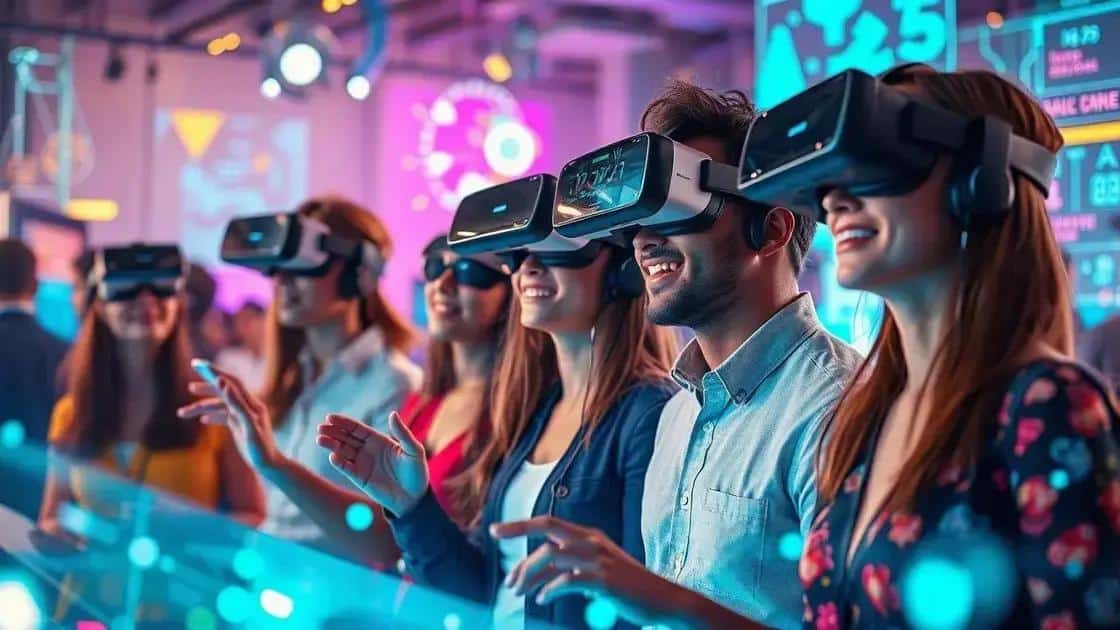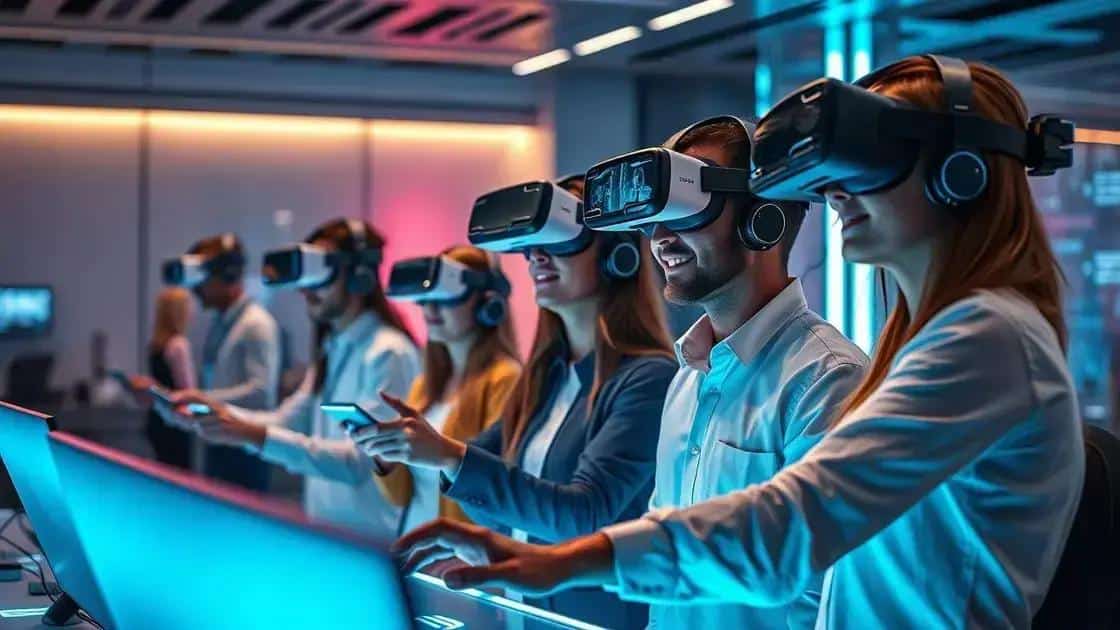Insights on vr/ar entertainment industry: explore the future

The VR/AR entertainment industry is rapidly evolving, enhancing user experiences through immersive gaming, interactive filmmaking, and seamless integration into daily life, promising a transformative future in various applications.
Insights on the VR/AR entertainment industry are unveiling a world of immersive experiences. Have you ever wondered how these technologies are changing the way we engage with entertainment? Let’s dive into what’s happening.
Current trends in vr/ar entertainment
As technology evolves, current trends in VR/AR entertainment are shaping how audiences experience narratives and interact with content. These advancements offer unique opportunities for storytelling and player engagement.
Immersive Storytelling
One trend is the rise of immersive storytelling. With VR technology, users can step into their favorite narratives, influencing outcomes and becoming part of the story themselves. This level of engagement is revolutionary.
Enhanced Interactivity
Furthermore, AR applications enhance interactivity by blending digital elements with the real world. Gamers and viewers can interact with characters and objects that seem to exist in their environment, creating a seamless blend of reality and fantasy.
- Gamification is becoming essential in entertainment, encouraging player participation.
- Users are now more than just spectators; they become active participants.
- Augmented reality experiences are expanding beyond games into various media.
Moreover, social VR experiences are evolving. Platforms are allowing friends and families to share virtual spaces, regardless of their physical location. This connectivity enriches relationships and adds a social dimension to entertainment.
In addition, the demand for high-quality graphics and audio experiences is on the rise. Today’s users expect realism and immersion that transport them entirely into another world. Developers are responding by creating stunning visuals and sounds that enhance user experiences.
- AR applications often use location-based services for tailored experiences.
- Advances in hardware make VR more accessible and appealing.
- The entertainment industry is increasingly collaborating with tech giants for innovative content.
These current trends in VR/AR entertainment highlight a remarkable shift in how stories are told and experienced. As audiences seek deeper interactions, the future promises even more exciting developments.
Impact of technology on user experience

The impact of technology on user experience is profound, especially in the world of VR and AR entertainment. As technology advances, it enhances how users interact with content, making experiences more immersive and engaging.
Personalization in Experiences
One major effect is the ability to personalize experiences. Technologies analyze user preferences, providing tailored content and recommendations. This means users enjoy experiences more suited to their tastes.
- Adaptive difficulty levels make games more enjoyable.
- Content recommendations keep users engaged with new experiences.
- Customizable avatars and settings enhance personal connection.
Moreover, technological advancements have led to improved graphics and sound quality. Users today expect high fidelity that brings scenes to life, enhancing immersion. This has resulted in designers prioritizing realism and sensory richness in their creations.
Social Interactions
Technological innovations also impact social interactions within virtual spaces. VR and AR platforms allow users to connect and engage with friends and strangers in new ways. These social environments foster community and collaboration, making the experiences richer.
- Virtual meetups provide shared experiences, regardless of distance.
- Social gaming features encourage teamwork and competition.
- Augmented environments enable real-life social activities in a virtual context.
Furthermore, user feedback is more critical than ever. Companies now gather data on user experiences to enhance future offerings. This continuous improvement creates an ongoing dialogue between developers and users, leading to more satisfying results.
As we consider the impact of technology on user experience, it’s clear that these advancements not only enhance engagement but also redefine how users connect with entertainment. The future holds even more exciting possibilities as technology continues to evolve.
Popular applications of vr/ar in entertainment
Popular applications of VR/AR in entertainment are transforming how audiences experience games, movies, and live events. These technologies provide immersive and interactive experiences that captivate users like never before.
Gaming Innovations
In the gaming sector, VR has revolutionized gameplay. Players can step into entirely different worlds, undergoing adventures that feel incredibly real. With advancements in motion tracking and haptic feedback, users interact with environments in fascinating ways.
- VR games like Beat Saber allow players to engage physically while having fun.
- Augmented reality games like Pokémon Go blend the virtual and real worlds seamlessly.
- Escape room experiences in VR take teamwork and puzzle-solving to new levels.
Moreover, AR enhances traditional gaming experiences by adding layers of information. This creates opportunities to engage players in a visually appealing manner that encourages exploration and creativity. With games becoming more social, players often find communities that enhance their enjoyment.
Immersive Movie Experiences
Virtual reality also finds its place in film and storytelling. Filmmakers use VR to create engaging narratives where viewers become part of the action. This new storytelling approach allows audiences to explore settings in ways that traditional films cannot offer.
- Interactive documentaries provide insights that allow the audience to explore topics deeply.
- Some films offer VR experiences that let viewers choose alternate endings.
- Filmmakers are experimenting with POV storytelling to immerse audiences fully.
At live events, AR applications enhance audiences’ experiences. Attending concerts or sports games can be enriched with augmented displays that provide real-time stats and interactive features. These applications engage attendees and add layers to their enjoyment.
From gaming to filmmaking to live events, the popular applications of VR/AR in entertainment highlight the potential of technology. As creativity and innovation continue to merge, audiences can expect even more exciting developments in the future.
Future predictions for the vr/ar industry

The future predictions for the VR/AR industry are exciting and full of potential. As technology continues to evolve, we can expect remarkable advancements that will change how we interact with both virtual and augmented realities.
Enhanced User Experience
One major trend is the improvement of user experience. Future VR and AR systems will likely offer greater realism and interactivity. Developers are expected to focus on creating more intuitive interfaces that engage users deeply.
- Haptic feedback will allow users to feel sensations, enhancing immersion.
- Eye-tracking technology will offer personalized experiences.
- Adaptive environments will respond to users’ actions in real-time.
Moreover, as hardware becomes more affordable and accessible, we may see a rise in consumer adoption. Users will enjoy high-quality experiences without needing expensive equipment. This widespread availability could lead to a surge in content creation.
Integration with Daily Life
In addition to entertainment, future VR and AR applications are expected to integrate into daily life more seamlessly. These technologies could assist in areas such as education, training, and remote work, providing tools that enhance productivity.
- AR will facilitate real-time collaboration in virtual workspaces.
- Immersive learning experiences can become standard in education.
- Virtual training simulations will prepare professionals for real-world scenarios.
As the VR/AR industry matures, we can also expect more companies to invest in creating content tailored to specific markets. This could lead to niche applications flourishing alongside mainstream entertainment.
Overall, the trends suggest that the future will be characterized by deeper engagement, broader accessibility, and innovative applications that expand beyond entertainment. The potential for technology to enhance our lives is vast.
In conclusion, the VR and AR industries are rapidly evolving, making exciting changes in how we experience entertainment and interact with technology. As we look ahead, we can expect to see even more innovative applications that enhance our daily lives, provide deeper engagement, and broaden accessibility. These advancements will not only refine entertainment but will also transform education, work, and social interactions. The future holds much promise for these immersive technologies, bringing them closer to our everyday experiences.
FAQ – Frequently Asked Questions about the VR/AR Entertainment Industry
What are the main applications of VR in gaming?
VR in gaming allows players to immerse themselves in virtual worlds, enhancing their gameplay experience through realistic graphics and interactivity.
How does AR enhance live events?
AR adds interactive elements to live events, such as real-time stats and a richer viewer experience, making events more engaging.
What is the future of VR/AR in education?
The future of VR/AR in education includes immersive learning experiences that can transform traditional teachings into interactive sessions.
How do technological advancements affect user engagement?
Technological advancements improve user engagement by offering more realistic and personalized experiences, making interactions more meaningful.





